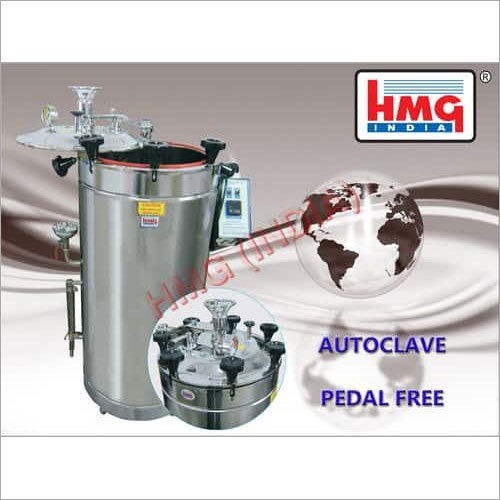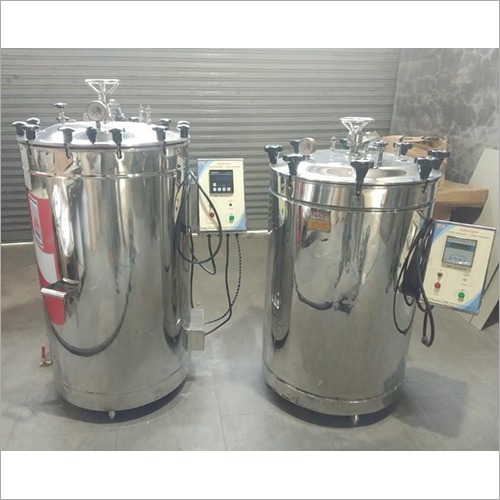Product Description
A single lever autoclave, also known as a single lever sterilizer, is a type of sterilization equipment commonly used in medical and laboratory settings to sterilize instruments, equipment, and other materials. Autoclaves use high-temperature steam and pressure to kill or inactivate microorganisms, including bacteria, viruses, and spores, making them an essential tool for infection control and ensuring the sterility of medical and scientific instruments.
The "single lever" aspect of this autoclave refers to its control mechanism. It typically features a single lever or knob that can be manipulated to control various functions of the autoclave, such as temperature, pressure, and duration of the sterilization cycle. This design simplifies the operation of the autoclave, making it user-friendly and efficient.
# The basic steps for using a single lever autoclave are as follows:
1. Load the items to be sterilized into the autoclave chamber. Make sure they are properly arranged and separated to allow for effective steam penetration.
2. Add water to the autoclave's water reservoir, which is essential for generating steam. The water level should be maintained at an appropriate level.
3. Set the temperature, pressure, and sterilization time using the single lever or control knob on the autoclave. The specific settings will depend on the type of material being sterilized and the autoclave's capabilities.
4. Start the autoclave, and the sterilization process will begin. The autoclave will heat the water to create steam, and the pressure and temperature will rise to the predetermined levels. This kills the microorganisms on the items inside.
5. Once the sterilization cycle is complete, the autoclave will automatically release the pressure and temperature. You can then safely open the autoclave door and remove the sterilized items.
# Applications of Single Lever Autoclave:
Single lever autoclaves, like other autoclaves, have a wide range of applications in various fields due to their ability to sterilize equipment and materials effectively. Here are some common applications of single lever autoclaves:
1. Healthcare Settings:
a. Sterilization of surgical instruments: Single lever autoclaves are extensively used in hospitals and clinics to sterilize surgical instruments, ensuring that they are free from pathogenic microorganisms before use in surgical procedures.
b. Sterilization of medical equipment: Autoclaves are used to sterilize a variety of medical equipment, such as syringes, gloves, bandages, and dressings.
c. Sterilization of laboratory glassware: Autoclaves are used in clinical and research laboratories to sterilize glassware, petri dishes, and other lab equipment.
2. Pharmaceutical Industry:
a. Sterilization of drug production equipment: Single lever autoclaves are used in pharmaceutical manufacturing to sterilize equipment used in drug production, ensuring product purity and safety.
b. Sterilization of packaging materials: Autoclaves are used to sterilize packaging materials, including vials, containers, and stoppers, to maintain product sterility.
3. Research Laboratories:
a. Sterilization of laboratory tools and media: Autoclaves are essential for maintaining sterile conditions in research laboratories by sterilizing tools, culture media, and solutions.
b. Sterilization of biohazard waste: Research facilities use autoclaves to sterilize biohazardous waste materials, such as used lab cultures and contaminated equipment.
4. Food Industry:
a. Sterilization of food processing equipment: Single lever autoclaves are used to sterilize equipment used in food processing, ensuring that food products are safe for consumption.
b. Sterilization of canning and packaging materials: Autoclaves are employed in canning processes to sterilize cans and jars before filling them with food.
5. Dental Clinics:
a. Sterilization of dental instruments: Autoclaves play a vital role in dental clinics by sterilizing dental instruments and handpieces to prevent cross-contamination between patients.
6. Veterinary Practices:
a. Sterilization of veterinary instruments: Autoclaves are used in veterinary practices to ensure that surgical instruments and equipment are sterile before veterinary procedures.
7. Research and Biotechnology:
a. Sterilization of laboratory waste: In research and biotechnology laboratories, autoclaves are used to sterilize contaminated waste materials and biohazardous waste before disposal.
8. Beauty and Tattoo Studios:
a. Sterilization of tattoo and piercing equipment: Autoclaves are used in the beauty and tattoo industry to sterilize needles, tubes, and other equipment to prevent infections and ensure customer safety.
# Single Lever Autoclave FAQ:
Q. What is a single lever autoclave?
Ans: A single lever autoclave is a type of autoclave or sterilization equipment that features a simplified control mechanism. It typically has a single lever or knob that can be used to control various functions, such as temperature, pressure, and sterilization time. This design makes it user-friendly and efficient for sterilizing equipment and materials.
Q. How does a single lever autoclave work?
Ans: A single lever autoclave works by using high-pressure steam to sterilize items placed inside its chamber. The single lever or control knob is used to set the desired temperature, pressure, and sterilization time. Once the autoclave is started, it heats water to produce steam, and the pressure and temperature are raised to levels that effectively kill microorganisms. After the sterilization cycle is complete, the autoclave releases pressure and temperature, allowing safe access to the sterilized items.
Q. What can be sterilized using a single lever autoclave?
Ans: Single lever autoclaves can be used to sterilize a wide range of items and materials, including surgical instruments, medical equipment, laboratory glassware, culture media, packaging materials, dental instruments, food processing equipment, and more.
Q. What are the advantages of a single lever autoclave?
Ans: The main advantage of a single lever autoclave is its ease of use. The single lever or control knob simplifies the sterilization process, making it user-friendly. Additionally, autoclaves, in general, are known for their effectiveness in killing a wide range of microorganisms, including bacteria, viruses, and spores, ensuring the sterility of the items they process.
Q. Are there any limitations to using a single lever autoclave?
Ans: Single lever autoclaves, like all autoclaves, have limitations related to the types of materials they can process. Some heat-sensitive materials and items that may be damaged by moisture or high temperature and pressure cannot be sterilized using this method. It's essential to ensure that the materials you wish to sterilize are compatible with autoclaving.
Q. What are the safety precautions when using a single lever autoclave?
Ans: Safety precautions include wearing appropriate personal protective equipment (PPE), following manufacturer's instructions, ensuring the autoclave is properly maintained and functioning, and being cautious when handling hot items after sterilization.
Q. How often should a single lever autoclave be serviced or maintained?
Ans: Regular maintenance and servicing are crucial to ensure the reliable and safe operation of a single lever autoclave. The frequency of maintenance depends on usage and manufacturer recommendations. Routine checks and calibrations are typically required to maintain the autoclave's performance.
Q. Can I use tap water in a single lever autoclave?
Ans: It's essential to use distilled or deionized water in an autoclave to prevent mineral deposits and scale buildup in the autoclave's chamber and components, which can affect its performance and lifespan.
Q. Can a single lever autoclave be used for liquid sterilization?
Ans: Yes, many single lever autoclaves can be used for liquid sterilization, but it's essential to follow the manufacturer's guidelines and set the appropriate cycle parameters to ensure effective sterilization of liquids.
Q. What is the difference between a single lever autoclave and other types of autoclaves?
Ans: The main difference is in the control mechanism. Single lever autoclaves have a simplified control interface, which makes them easier to operate. Other autoclaves may have more complex control systems or programmable features for specific applications.


 English
English Spanish
Spanish French
French German
German Italian
Italian Chinese (Simplified)
Chinese (Simplified) Japanese
Japanese Korean
Korean Arabic
Arabic Portuguese
Portuguese



